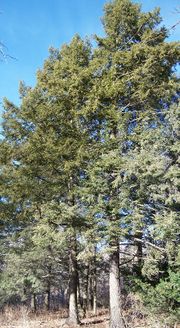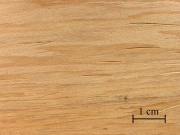Difference between revisions of "Eastern hemlock"
| (5 intermediate revisions by 2 users not shown) | |||
| Line 1: | Line 1: | ||
| − | [[File:09_EasternHemlock.jpg|thumb|Eastern Hemlock | + | [[File:Tsuga canadensis morton.jpg|thumb|Eastern Hemlock (''Tsuga canadensis''); Credit: Bruce Morton]] |
| + | [[File:09_EasternHemlock.jpg|thumb|Eastern Hemlock (''Tsuga canadensis'')]] | ||
| − | |||
== Description == | == Description == | ||
| − | A hemlock tree, ''Tsuga canadensis'', native to eastern North America, ranging from Alabama to New England and west to Wisconsin. | + | A hemlock tree, ''Tsuga canadensis'', native to eastern North America, ranging from Alabama to New England and west to Wisconsin. Eastern hemlock trees generally grow to 31 with trunk diameters of 1.8 m. It typically has a straight trunk with horizontal branches that droop to the ground. It is the state tree of Pennsylvania. The softwood tree produces coarse-grained wood that is strong, lightweight, and splinters easily. It is used primarily for paper pulp, but also for boxes, crates and railroad ties. Tannins extracted from the bark are used to make leather. The Eatern Hemlock is the state tree for Pennsylvannia. The tree is killed by a non-native insect (''hemlock woolly adelgid'') |
See also [[hemlock bark]]. | See also [[hemlock bark]]. | ||
| Line 12: | Line 12: | ||
''Tsuga canadensis; Tsuga mertensiana'' (19th c.); sapinette noire (Fr.); sapinette du Canada (Fr.); Canada hemlock; Canadian hemlock; American hemlock; hemlock spruce | ''Tsuga canadensis; Tsuga mertensiana'' (19th c.); sapinette noire (Fr.); sapinette du Canada (Fr.); Canada hemlock; Canadian hemlock; American hemlock; hemlock spruce | ||
| − | + | ==Risks== | |
| − | + | * May cause skin irritation | |
| − | |||
| − | |||
| − | |||
| − | == | + | ==Physical and Chemical Properties== |
| + | * Color: heartwood is reddish brown; sapwood is slightly lighter | ||
| + | * Grain/Texture: Straight grain with coarse uneven texture | ||
| + | * Durability: non-resistant to decay; susceptible to insect attack. | ||
| + | * Density = 28 pcf | ||
| + | * Odor: not distinctive | ||
| + | |||
| + | ==Working Properties== | ||
| + | |||
| + | * Tends to splinter easily and plane poorly. | ||
| + | * Because of the disparity between the soft earlywood and the hard latewood, sanding can create dips and uneven surfaces. | ||
| + | * Glues, stains, and finishes well. | ||
| + | ==Resources and Citations== | ||
| + | * The Wood Database: [https://www.wood-database.com/eastern-hemlock/ Eastern hemlock] | ||
| + | * Wikipedia: https://en.wikipedia.org/wiki/Tsuga_canadensis (accessed April 2020) | ||
* G.S.Brady, ''Materials Handbook'', McGraw-Hill Book Co., New York, 1971 Comment: p. 394 | * G.S.Brady, ''Materials Handbook'', McGraw-Hill Book Co., New York, 1971 Comment: p. 394 | ||
| Line 26: | Line 37: | ||
* External source or communication Comment: Northern Hemlock and Hardwood Manufacturuers Association, Oshkosh, Wis.: air-dry weight = 28 pcf | * External source or communication Comment: Northern Hemlock and Hardwood Manufacturuers Association, Oshkosh, Wis.: air-dry weight = 28 pcf | ||
| − | * ''Encyclopedia Britannica'', http://www.britannica.com Comment: "Hemlock." | + | * ''Encyclopedia Britannica'', http://www.britannica.com Comment: "Hemlock." Accessed 18 Aug. 2004 . |
* Gordon Hanlon, contributed information, 1998 | * Gordon Hanlon, contributed information, 1998 | ||
Latest revision as of 11:57, 1 August 2022
Description
A hemlock tree, Tsuga canadensis, native to eastern North America, ranging from Alabama to New England and west to Wisconsin. Eastern hemlock trees generally grow to 31 with trunk diameters of 1.8 m. It typically has a straight trunk with horizontal branches that droop to the ground. It is the state tree of Pennsylvania. The softwood tree produces coarse-grained wood that is strong, lightweight, and splinters easily. It is used primarily for paper pulp, but also for boxes, crates and railroad ties. Tannins extracted from the bark are used to make leather. The Eatern Hemlock is the state tree for Pennsylvannia. The tree is killed by a non-native insect (hemlock woolly adelgid)
See also Hemlock bark.
Synonyms and Related Terms
Tsuga canadensis; Tsuga mertensiana (19th c.); sapinette noire (Fr.); sapinette du Canada (Fr.); Canada hemlock; Canadian hemlock; American hemlock; hemlock spruce
Risks
- May cause skin irritation
Physical and Chemical Properties
- Color: heartwood is reddish brown; sapwood is slightly lighter
- Grain/Texture: Straight grain with coarse uneven texture
- Durability: non-resistant to decay; susceptible to insect attack.
- Density = 28 pcf
- Odor: not distinctive
Working Properties
- Tends to splinter easily and plane poorly.
- Because of the disparity between the soft earlywood and the hard latewood, sanding can create dips and uneven surfaces.
- Glues, stains, and finishes well.
Resources and Citations
- The Wood Database: Eastern hemlock
- Wikipedia: https://en.wikipedia.org/wiki/Tsuga_canadensis (accessed April 2020)
- G.S.Brady, Materials Handbook, McGraw-Hill Book Co., New York, 1971 Comment: p. 394
- Dictionary of Building Preservation, Ward Bucher, ed., John Wiley & Sons, Inc., New York City, 1996
- External source or communication Comment: Northern Hemlock and Hardwood Manufacturuers Association, Oshkosh, Wis.: air-dry weight = 28 pcf
- Encyclopedia Britannica, http://www.britannica.com Comment: "Hemlock." Accessed 18 Aug. 2004 .
- Gordon Hanlon, contributed information, 1998
- Random House, Webster's Encyclopedic Unabridged Dictionary of the English Language, Grammercy Book, New York, 1997

